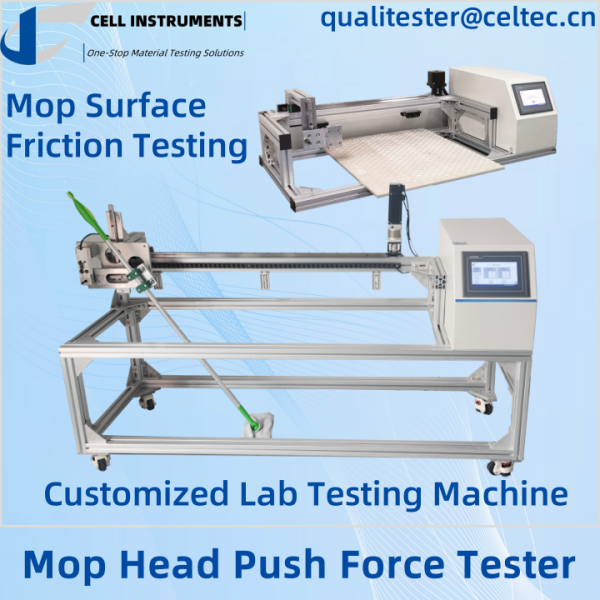The Importance of Mop Head Push Force Test in Improving Cleaning Efficiency
The mop head push force test is a critical procedure for evaluating the effectiveness of cleaning materials, particularly mop heads. This test measures the force required to push the mop across a surface, providing essential data on the product’s performance. As the demand for high-quality cleaning products increases, manufacturers need reliable methods to ensure their products meet rigorous standards. In this article, we will explore the significance of the mop head push force test, its applications, and the role of Cell Instruments’ mop friction testing machine in performing these evaluations accurately.
Importance of Mop Head Push Force Test
Testing the push force of a mop head is essential to determine its efficiency and ease of use. A mop that requires too much force to push across surfaces may tire the user quickly, leading to inefficiency in large cleaning tasks. On the other hand, if the force is too low, the mop might not provide adequate cleaning power. Thus, the mop head push force test ensures a balance between user comfort and cleaning effectiveness, making it an integral part of product development and quality assurance.
This test is particularly beneficial for:
- Home cleaning products: Ensuring mops are suitable for everyday household cleaning.
- Industrial cleaning tools: Testing industrial-grade mops for large-scale operations.
- Medical environments: Evaluating mops used in sterile settings where hygiene is paramount.
Mop Surface Friction Test: Complementary Evaluation
Alongside the push force test, the mop surface friction test measures the resistance between the mop and the surface it cleans. This test ensures that the friction generated during cleaning is neither too high (leading to difficulty in movement) nor too low (resulting in poor cleaning). It is particularly crucial for environments where precision cleaning is required, such as hospitals and laboratories.
Step-by-Step Guide to Mop Head Push Force Test
- Sample Preparation: Secure the mop head sample onto the testing machine.
- Setup and Calibration: Adjust the testing parameters, including the pressure and speed, based on the type of surface being cleaned (e.g., tile, wood, or glass).
- Testing Execution: Initiate the test by pushing the mop head across the surface while the machine measures the required force. Repeat the test on multiple surfaces to ensure consistency.
- Data Collection: Record the results, noting variations in push force across different surfaces.
- Analysis: Compare the data against industry standards to determine the mop’s overall performance and efficiency.
Advantages of Using the Cell Instruments Mop Friction Testing Machine
At Cell Instruments, our advanced mop friction testing machine offers a precise and reliable method to conduct both push force and surface friction tests. Key features include:
- 7-inch Human-Machine Interface: A user-friendly touchscreen that simplifies operation.
- High-Precision Loadcell: Ensures accuracy in force measurement, with a 0.5% Full-Scale (FS) precision.
- Adjustable Testing Speed: Adaptable to various testing requirements, allowing a range of 1 to 60,000 mm/min.
- Real-Time Data Display: Provides immediate feedback, allowing users to monitor the test in progress.
With these advanced features, the machine ensures that manufacturers can produce high-quality, efficient cleaning products that meet both industry standards and consumer expectations.
Customization and Flexibility
Understanding that different industries have unique testing requirements, Cell Instruments offers customization options for the mop friction testing machine, including:
- Software Customization: Tailor the software to suit specific testing protocols.
- Fixture Customization: Modify fixtures to accommodate various cleaning materials, from microfiber mops to industrial scrubbers.
This flexibility allows manufacturers to ensure their products are tested under conditions that closely simulate real-world use, resulting in accurate and reliable data.
Key Applications
The mop head push force test is applicable in various industries:
- Household Cleaning: Ensures mops used in homes are easy to maneuver while providing effective cleaning.
- Industrial Cleaning: Tests heavy-duty mops for use in large facilities, ensuring durability and efficiency.
- Medical and Pharmaceutical: Assesses the suitability of mops used in sterile environments, where both friction and cleaning efficiency are crucial.
FAQ: Mop Head Push Force Testing
Why is the mop head push force test important? The push force test helps determine the ease of use and effectiveness of a mop, ensuring that it provides adequate cleaning without being too strenuous to use.
What surfaces are tested during the mop head push force test? Common surfaces include tile, wood, glass, and other materials that mimic real-world cleaning environments.
How does the mop surface friction test complement the push force test? While the push force test measures the effort needed to move the mop, the surface friction test assesses the resistance between the mop and the surface, ensuring balanced performance.
Can the Cell Instruments testing machine be customized? Yes, Cell Instruments offers various customization options, including software and fixture adjustments, to meet specific testing needs.
What industries benefit the most from mop head push force testing? Industries such as household cleaning, industrial cleaning, and healthcare benefit greatly from this testing, ensuring products meet specific performance standards.
By integrating advanced testing technologies like those offered by Cell Instruments, manufacturers can significantly enhance the performance and quality of their cleaning products.
Related Products
Related Article
Mop Coefficient of Friction Tester

